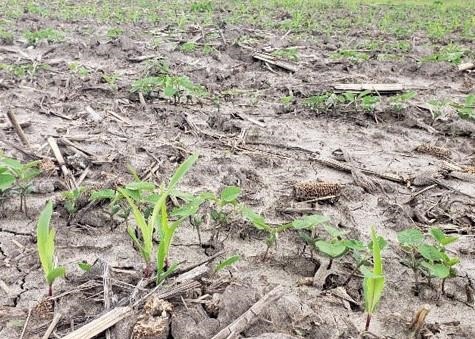By Sarah Lancaster
We can debate whether or not volunteer corn is truly a “weed”, but it is definitely a problem for soybean farmers (Figure 1). Soybean yield loss was 8 to 9% when volunteer corn density was about 1 plant per 10 square feet and yield loss increased to 71% at volunteer corn densities of about one plant per square foot, according to research conducted in South Dakota.
One of the factors that makes volunteer corn management difficult in soybeans is that this corn is typically resistant to glyphosate and/or glufosinate, and dicamba and 2,4-D do not control it. In addition, tank mixes with dicamba or 2,4-D may reduce the effectiveness of glyphosate and Group 2 herbicides like clethodim (Select Max, others) or quizalofop (Assure II, others). However, there are some steps farmers can take early in the growing season to manage volunteer corn in soybean crops.

Figure 1. Volunteer corn emerging with soybeans. Photo by Sarah Lancaster, K-State Research and Extension.
Burndown options
As mentioned above, glyphosate will not control glyphosate-resistant corn. Paraquat (Gramoxone, others) will control volunteer corn that has emerged prior to soybean planting. Glufosinate (Liberty, others) will also control volunteer corn – assuming the corn is not glufosinate-resistant (LibertyLink). One thing to remember with burndown herbicide applications is that they must come in contact with the growing point to ensure the corn plant will not regrow.
At planting options
In research conducted at the University of Nebraska, pre-emergence applications of sulfentrazone in combination with imazethapyr, cloransulam, metribuzin, or chlorimuron (Authority Assist, Authority First, Authority MTZ, or Authority XL) reduced volunteer corn growth compared to non-treated controls. Other treatments, including flumioxazin (Valor, others) alone or in combination with chlorimuron (Valor XLT) or cloransulam (Gangster), or fomesafen + metolachlor (Prefix) or saflufenacil + imazethapyr (Optill) did not reduce volunteer corn growth.
Over-the-top options
Group 2 herbicides (Select Max, Assure II, Fusilade, Poast, and others) are typically very effective on volunteer corn. However, research from Indiana suggest that volunteer corn control by clethodim formulations without ‘fully loaded’ surfactants can be reduced up to about 60% when applied with glyphosate or glyphosate plus 2,4-D and up to about 75% when applied with glyphosate plus dicamba. Reduced control in tank mixes can be overcome by increasing the rate of the Group 2 herbicide to the maximum labeled rate. The loss of control can also be minimized by using a clethodim formulation with a more aggressive surfactant package. In addition, research from North Dakota suggests that adding a high surfactant oil concentrate (HSOC) can improve volunteer corn control by tank mixtures of clethodim plus glyphosate, but neither NIS nor AMS improve control.
Source : ksu.edu